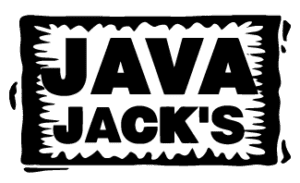The Roaster’s Challenge – Day 2
After a great first day, the second day of the Roaster’s Guild retreat started with a great breakfast and some time for each team in this years roasting challenge to meet and finalize their coffees for submission. We were looking forward to spending some time cupping a few batches of coffees we had roasted on the previous evening and wanted to develop the coffee we would submit to the judges.
We quickly found out the all the other teams were doing the same thing. So when we arrived to the cupping room we entered a busy room with each team discussing their strategy as well. Needless to say the room wasn’t large enough to hold everybody and not enough tables for all the teams to spend the precious time cupping their coffee for the challenge.
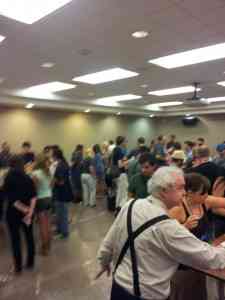
Madhouse around the Cupping table
So we found a quiet spot and sat down to blended the two coffees we felt were the best example of a fine Brazilian coffee. We decided to go with a 50/50 blend. we started with Coffee #1 that had a very pounced citrus acidity not normally found in Brazilian coffees and added Coffee #4 that had a more traditional Brazil profile with muted acidity and a pronounced creamy body with hints of nuts and coco. We enjoyed this coffee and felt the combination of the two gave the cup a very delicate and approachable character with a good balance and a pleasing aftertaste.
Both coffees were roasted to a medium roast level for 11-12 minutes to just 410-415 degrees for the beans internal temperature. We refer to this medium degree of roast as City+, just before the second crack or Full City where the caramelized sugars start to move into a deeper toned cup of coffee offering more roast flavors to the cup. We felt the judges wouldn’t want to see a full city developed coffee for this judging but as we found out later that wasn’t the case…
Next we developed and documented our roasting concepts regarding the choice of coffees and the roast degree used. Thanks to Dan for taking the time to write a great description for the judges that really shared or ideas as a team and the resulting blend.
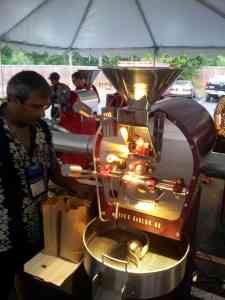
Dan prepping the Diedrich for roasting
Skill Building Courses
It was time to go to our first of two skill building courses. The Roasters Guild offers a Certification Program that recognizes specialty roasters who are able to achieve a high degree of skill and excellence in coffee roasting, across three levels: Apprentice, Journeyman and Master. The courses focus on a variety of topics and issues relevant to today’s marketplace and business demands. Course subjects range from the practical (identifying defects, plant safety, green coffee processing) to the scientific (sensory science, heat transfer & thermodynamics, particle size analysis)
We were able to choose between 6 different courses offered at this years retreat.
The basics of coffee processing, market strategies, sample roasting, profile roasting practices, SCAA cupping forms/peer calibration, air quality from the roaster, and the essentials of inventory management.
I had the opportunity to complete a few of these on my Origin rip to Honduras in 2011 so I choose to attend the Profile Roasting Practices and SCAA Cupping form/Peer Calibration, two courses I needed to complete so I would be a few steps closer towards completing the journeyman level requirements.
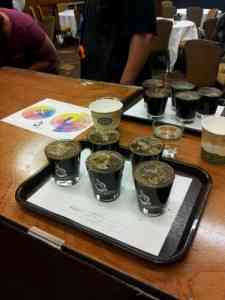
Cupping Form Evaluation
Cupping and Peer Calibration
We had a great session in the cupping and peer calibration session. Here we were taught how to use the SCAA cupping form that scores the coffee on many aspects of the coffee taste generating a 100 point scale that will give us an indication regarding the quality of the coffee. the sections of the form include areas to score the fragrance, aroma, acidity, body, flavor, sweetness, clean cup, balance, aftertaste, and overall impressions and scoring each between 5-10 with a value for intensity as well.
The form also takes into account any defects, “taints”, which are defects that are noticeable but usually not overwhelming in aromatic aspect, has 2 points removed. “Faults” are an overwhelming defect typically characterized as a sour, ferment, or phenolic in the coffee itself and allows us to subtract 4 points for each. Once all the scores have been assessed, we subtract for any defects that may have been present and get a final score that places the coffee in a SCAA standard classification.
| Final Score | Classification |
| 95-100 | Super Premium Specialty |
| 90-94 | Premium Specialty |
| 85-89 | Specialty |
| 80-84 | Premium |
| 75-79 | Usual God Quality (UGQ) |
| 70-74 | Average Quality |
| 60-70 | Exchange Grade |
| 50-60 | Commercial Grade |
| 40-50 | Below Grade |
| < 40 | Off Grade |
Sizing up the Competition
Over a great lunch provided by the Skamania lodge we had an opportunity to talk with the other teams and see how their roasting challenge was shaping up. We also wanted to see if there was something we could learn from their experiences.
One thing I noticed is that on one particular machine that was provided everyone had trouble controlling the gas level for the burners during particular critical stages of the roasting process. Needless to say, we went through some of our allotted coffees and were kinda frustrated with the outcome, but I was glad to hear that we weren’t the only team with the same troubles and concerns we had encountered the day before.
Lunch was the deadline for the challenge coffee to be submitted so with our fingers crossed we provided the judges with our roast so they could spend the afternoon choosing this years winner.
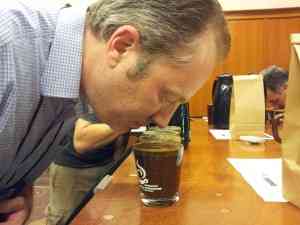
Evaluating the Aroma
After lunch we attended the second of our skill building courses. I had chosen the Profile Roasting practices which is a hands on roasting workshop designed to help a roaster define and apply profile roasting practices. These practices guide how the coffee is developed during the roasting process and what flavors or attributes are created by changing the profile.
There was a short lecture that focused on profile definitions, and we were given a form to track the time and temp curve of the profile we choose to follow.
We were asked to roast two different batches of the same coffee using two different profiles, one with a slow gradual finish and the other with a more aggressive rapid finish but keeping the length of roast the same. Then we followed up with a comparative cupping of both coffees to see how each profile affected the taste of the coffee. We then disused the merits of each profile and returned to the roaster to do a third batch with a gradual finish to see if we could make and improvement on the two earlier profiles.
In profile roasting, you can chose to roast a shorter time, longer time, reduce heat levels, and manage air flows on the roasters, but I sensed there aren’t really a lot of hard and fasts rules just some guidelines to follow and not until we cup the coffee are we able to determine if that’s the proper profile for that coffee or the taste we want to present to our customers.
I really enjoyed working on the program and learned a lot of info I will to able to incorporate in our process at the coffee roaster to help dial in the best possible product we can offer.
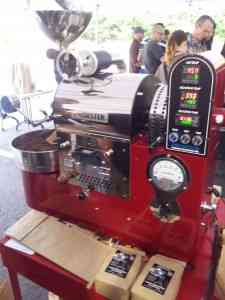
Working with the Proaster
The days ended with a silent auction that included many donated items from our weekend sponsors. These included coffee brewers, grinders, industry related books, tools and a few t-shirts and as well some great local craft beers. The auction had been open all weekend and all proceeds benefited Coffee Kids. The auction raised over $8,000 for a wonderful charity that supports coffee communities in growing countries.
We had a fun and very social dinner out on the front lawn of the lodge where we were treated to a great smoked salmon dinner that was cooked on a unique barbecue pit that had the salmon fillets standing vertical around a stack of charcoal briquets in the center, I’d love and try that technique the next time I’m smoking some ribs for the friends and family.
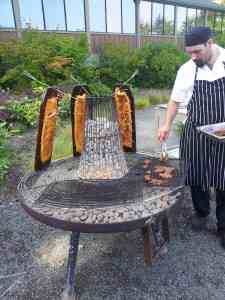
After dinner we moved to another area at the lodge to share some drinks and conversations around a bonfire. Everyone waited in anticipation of the announcement of the Roasters Challenge winning team. Phil Beattie, of Dillanos Coffee Roasters and the current chair of the Roasters Guild executive council, had the great pleasure of sharing with us the results of this years challenge. He introduced the top three teams and they were “The Crack Shots”, “Pulped Natural Fiction”, and “The Flaming Sacks”. Phil held the crowds attention as the suspense built. We all wanted to know which team had the highest rated coffee. The crowd erupted in cheers as he announced this years winners with a score of 85: “The Crack Shots”!
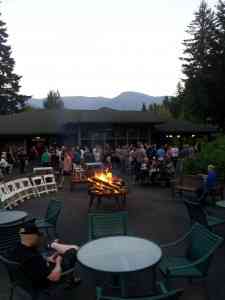
Bonfire
We all had a great time as they celebrated their win of this years challenge with many pictures and celebratory toast being made by everyone involved. The team name will be immortalized on the Roasters Guild Challenge Cup with all the previous years winners. It was a great evening to be outdoors, and many great friendships were cemented and wonderful stories were told long into the night around the warm glow of the bonfire.
I can’t wait to get back to start putting my new knowledge to use!

